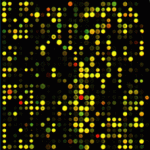Genomics
|
24 july 2014 08:06:37 |
| Genome sequence and virulence variation-related transcriptome profiles of Curvularia lunata, an important maize pathogenic fungus (BMC Genomics) |
|
Tweet Background:
Curvularia lunata is an important maize foliar fungal pathogen that distributes widely in maize growing area in China. Genome sequencing of the pathogen will provide important information for globally understanding its virulence mechanism.
Results:
We report the genome sequences of a highly virulent C. lunata strain. Phylogenomic analysis indicates that C. lunata was evolved from Bipolaris maydis (Cochliobolus heterostrophus). The highly virulent strain has a high potential to evolve into other pathogenic stains based on analyses on transposases and repeat-induced point mutations. C. lunata has a smaller proportion of secreted proteins as well as B. maydis than entomopathogenic fungi. C. lunata and B. maydis have a similar proportion of protein-encoding genes highly homologous to experimentally proven pathogenic genes from pathogen-host interaction database. However, relative to B. maydis, C. lunata possesses not only many expanded protein families including MFS transporters, G-protein coupled receptors, protein kinases and proteases for transport, signal transduction or degradation, but also many contracted families including cytochrome P450, lipases, glycoside hydrolases and polyketide synthases for detoxification, hydrolysis or secondary metabolites biosynthesis, which are expected to be crucial for the fungal survival in varied stress environments. Comparative transcriptome analysis between a lowly virulent C. lunata strain and its virulence-increased variant induced by resistant host selection reveals that the virulence increase of the pathogen is related to pathways of toxin and melanin biosynthesis in stress environments, and that the two pathways probably have some overlaps.
Conclusions:
The data will facilitate a full revelation of pathogenic mechanism and a better understanding of virulence differentiation of C. lunata. |
| 94 viewsCategory: Genomics |
 LTR retroelements are intrinsic components of transcriptional networks in frogs (BMC Genomics) LTR retroelements are intrinsic components of transcriptional networks in frogs (BMC Genomics)To the reference and beyond: understanding variation in plant genomes (Briefings in Functional Genomics and Proteomics) 
|
| blog comments powered by Disqus |
MyJournals.org
The latest issues of all your favorite science journals on one page
The latest issues of all your favorite science journals on one page



